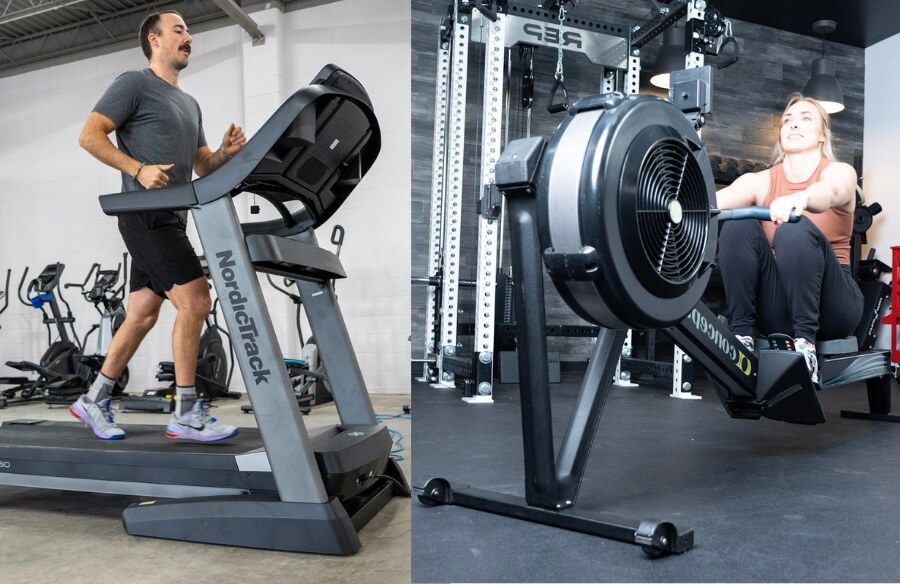We test and review fitness products based on an independent, multi-point methodology. If you use our links to purchase something, we may earn a commission. Read our disclosures.
To run or row—it could be your question. These two staple pieces of gym equipment—treadmill and rowing machine—work the body differently, but both put your cardiovascular system to the test. For an avid runner or rower, the answer is simple, but for those who are simply looking for an effective workout, the debate between the two is a little more complex.
One works the entire body while the other is a slightly better calorie torcher. As far as cons, one can strain the knees and the other the back. We compared the treadmill vs rowing machine to look more closely at similarities, differences, strengths, and weaknesses to identify the type of person who might benefit most from each machine.
Comparison Chart
| Treadmill | Rowing machine | |
| Average dimensions | 5-7′ long x 2-3′ wide | 6-7′ long x 2-2.5′ wide |
| Weight range | 220-350 lbs | 60-200 lbs |
| Maximum user weight capacity range | 200-400 lbs (advanced models) | 250-500 lbs |
| Noise level | 3-4 horsepower motors can be quite quiet, though foot noise can be an issue | Magnetic and water rowers tend to be quiet, while air rowers can be noisy |
| Price range | $300 to over $5,000 | $150 to over $3,000 |
| Interactive programming available | Some models | Some models |
| Foldable models available? | Yes | Yes |
Quick Look: Treadmill vs Rowing Machine
The cardiovascular results of using the best treadmill vs rowing machine can be fairly similar, but the road to getting those results looks and feels very different. It’s a lot like comparing apples and oranges—they’re both fruit (cardio machines), but the “flavor” of the machine will be perfect for some and disgusting for others. Make sure to compare specs like dimensions, maximum weight limit, portability, and price range. But also think about your workout style, medical/injury history, and the kind of cardio workout that offers long-term motivation for you.
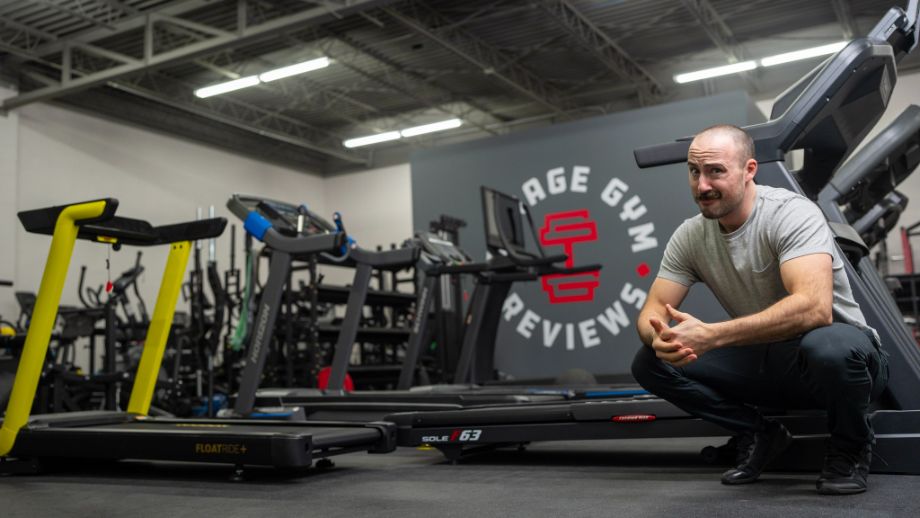
Who Should Buy a Treadmill
- People who want to maximize calorie burn
- Beginners and those who just want to hop on a machine and go
- People who have back problems
- People who have limited upper body mobility
- People with more space for fitness equipment
Who Should Buy a Rowing Machine
- People with knee problems
- People who want a full-body workout
- Beginners willing to work on proper form
- People who compare a treadmill to a hamster wheel
- People who want a lightweight cardio machine
Key Similarities Between a Treadmill and a Rowing Machine
- Both provide a solid cardio workout
- Fall into a similar price range
- High-end models with built-in screens
- Easy to use, even for beginners
- An excellent cardio machine for a home gym
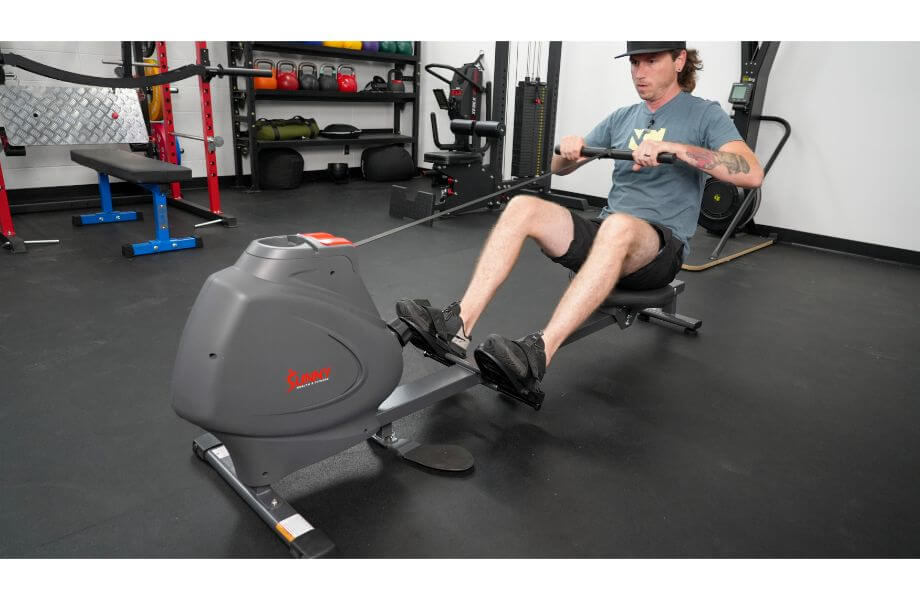
Important Differences Between a Treadmill and a Rowing Machine
- Treadmills are high-impact (lower for walking)
- Rowing machines are low impact
- Rowing machines activate the full body
- Treadmills primarily activate the lower body
- Treadmills offer more diverse workout options
- Rowing machines weigh less but can have a higher maximum weight capacity
Workout Feel
While these two machines can both offer an intense cardio workout, how that workout feels and the muscle groups it activates are very different. The moving belt of a treadmill mimics walking or running outside, which is primarily lower body movement. True, your arms move and pump, but you generally feel a treadmill workout your glutes, hamstrings, quads, and calves.
A treadmill workout is a high-impact exercise where the joints, especially the knees, absorb the shock of each footstep. A treadmill’s running surface, called a deck, may have some shock absorption, but there will be high stress put on the feet, ankles, knees, and hips.
A rowing workout feels completely different because a rowing machine mimics the movements associated with rowing a boat through water. The rowing stroke activates the upper and lower body as you push and pull at the same time. It requires leg, arm, shoulder, and back strength that’s not required for running or walking. The nature of the movement activates the whole body but doesn’t stress the knees, according to a 2013 study¹ published in the Journal of Engineering in Medicine.
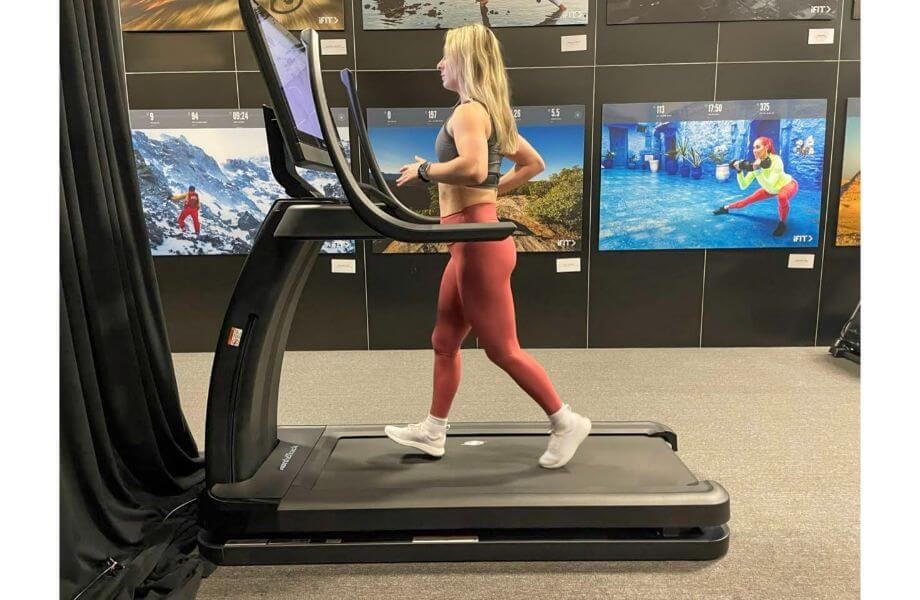
Before you strap your feet into a shiny new rowing machine, consider that there’s a small learning curve to developing your stroke. Some people find that rowing machines strain the lower back, even when they use correct form. According to a 2019 study² published in the International Journal of Research in Exercise Physiology, you burn 7.6 calories per minute on a rowing machine compared to 9.3 calories per minute on a treadmill.
You’ll have to consider that workouts aren’t just about calorie burn. One of the many benefits of rowing is how you can build muscle and burn calories versus on a treadmill, where you might build strength in your legs, but you’re primarily burning calories while improving your cardiovascular health.
Technology Comparison
The more advanced rowing machines and treadmills have some very similar technologies. For example, high-end treadmills and rowing machines may have a large touchscreen on which you can watch integrated programming or streaming entertainment. These models typically require a monthly subscription to a fitness app, giving access to trainer-led workouts. Some treadmills and rowing machines may include technology that also allows instructors to automatically adjust the treadmill’s speed and incline levels or resistance of the rower.
However, there are far more advanced treadmills with access to thousands of integrated workouts than there are rowing machines currently on the market. Rowing machines are more likely to have a simple LED display with the distance, watts, and time. There are a few advanced models with built-in screens where you can access workouts, leaderboards, and other interactive features. They often have a more game-like feel versus an advanced treadmill that creates sessions that feel more like you’re working with a personal trainer.
RELATED: Best Treadmill with TV Screen
Construction and Design Differences
Most of today’s treadmills have motors that range from 2.5 to 4.0 horsepower, with the more powerful motors offering faster speeds and the ability to run for more continuous hours. Treadmills are also made in two very broad categories—manual and motorized. There are a few small manual treadmills and under-desk treadmills at the bottom of the price range and $5,000 slat belt manual treadmills with curved decks at the top of the price range. In between are the mid-range, motorized models with which most people are familiar.
There’s a huge variety of price range, running surface sizes, and maximum weight capacities among treadmills. Entry-level models may only accommodate users up to 200 pounds walking at a maximum speed of 2.5 to 3.0 mph. Heavier duty models can reach 12 mph and accommodate users up to 400 pounds.
Both treadmills and rowing machines come in stationary or folding designs. The deck of a folding treadmill typically folds toward the console. While it doesn’t make a huge difference in the footprint, it can make them more convenient for smaller spaces. These treadmills may have transport wheels under the console so you can push them out of the way, too. Rowing machines often have a folding design that allows the rail and seat to fold toward the console. It makes for a tall but relatively thin piece of equipment. Considering that most rowing machines weigh less than a treadmill, they’re generally more portable.
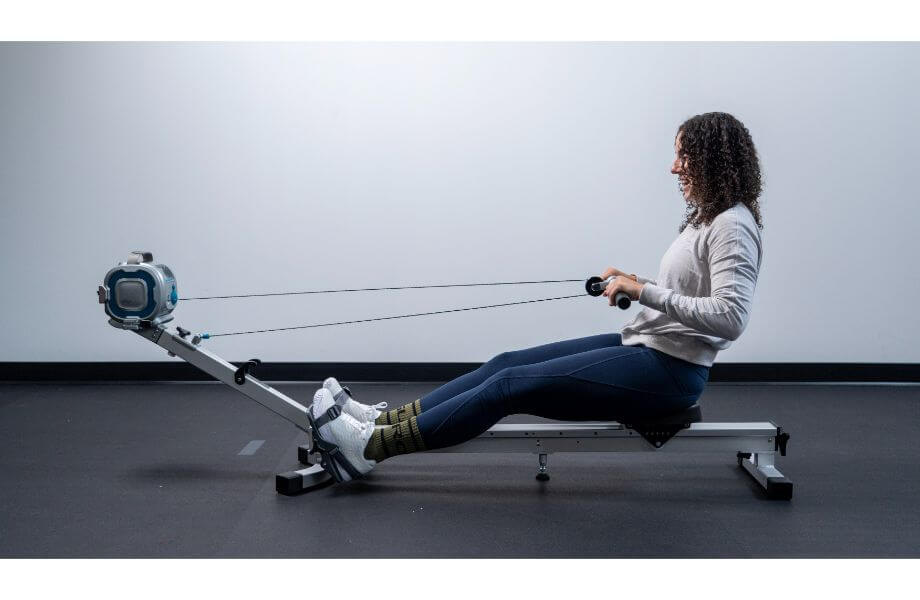
Rowing machines can be incredibly lightweight at around 60 pounds. These models may have a maximum weight capacity of around 250 pounds. Some of the heavier-duty models can weigh around 200 pounds but accommodate users up to 500 pounds, which is higher than any residential-grade treadmill.
There’s also more variety in the rowing machine construction and design, and they’re divided into four basic types:
- Water
- Air
- Magnetic
- Hydraulic
These four types function similarly but have some differences that can make one type a better fit than the other. For example, a water rowing machine feels (and sounds) more like rowing on open water. Competitive rowers often like them for the realistic experience. Air rowing machines use a fan blade and a flywheel to create resistance, increasing resistance as the strength of the stroke increases. Air rowers tend to be noisy, though they do create a nice breeze while you work out.
Magnetic rowing machines use magnetic eddy current resistance to increase or decrease forces on a metal flywheel. The resistance is adjusted using a manual button or dial, offering a wider variety of workout options than some of the other types of rowing machines. These models are also quieter than an air or water rowing machine.
Hydraulic rowing machines don’t have a flywheel, fan, or water. They offer a great upper body workout but do very little for the lower body. However, they’re quiet, compact, and lightweight, making them easy to store.
Which One Is Right For You?
Take a good look at your fitness goals and workout style. Treadmills offer a greater variety of workouts because you can use them to do high-intensity interval workouts (HIIT), intervals, hills, or heart rate workouts. Plus, you can walk or run at different speeds, inclines, or declines. Treadmills are also likely to have a media shelf on which you can watch content on a tablet or phone. Rowing machines don’t typically have media shelves, which means you’ll need something else to keep you entertained. However, if you have bad knees or joint pain in the lower body, a treadmill might cause pain or discomfort.
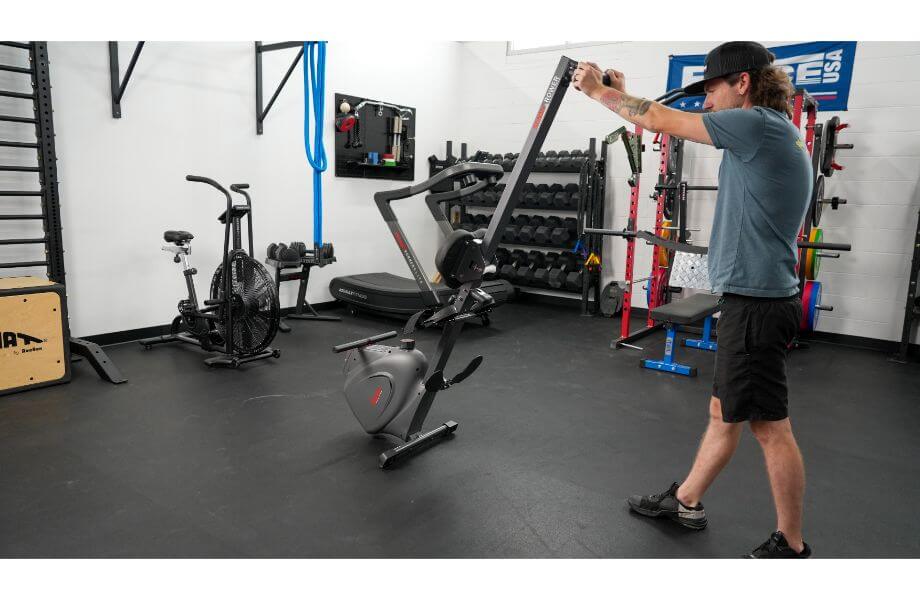
Rowing machines, on the other hand, allow you to row faster or slower, but there’s not as much workout variety. Some of the more expensive machines can connect to a fitness app that lets you race against other users or work your way up leaderboards. These models may be loaded with apps so you can watch entertainment programming. Rowing machines are also low impact for those with knee problems. But if you’ve got lower back issues, skip the rowing machine and opt for a treadmill.
Treadmill vs Rowing Machine: Final Thoughts
Both of these machines offer an incredible cardio workout that you can adjust to your fitness level. If you love to run and need variety in your workouts, a treadmill is an excellent choice. They’re easy to use, but they’re less portable and can be hard on your knees and joints.
Rowing machines aren’t difficult to use, but it might take a little work to develop your stroke. You’ll get a solid full-body workout, though there’s a little less workout variety and the potential to strain your lower back.
Either one is a great choice for a home gym, as long as you like it enough to use it regularly. Check your budget and available space, and put some serious thought into which machine will complement your workout style and goals.
Treadmill vs Rowing Machine FAQs
Is rowing better than a treadmill?
Rowing is better for your knees than a treadmill is, but as far as the cardio workout goes, it all depends on the strength of your stroke or how fast you run as to whether or not one offers a better workout for you.
Which is better for weight loss, a rowing machine or a treadmill?
Whichever machine you will use most consistently is the best one for your weight loss. Either machine can give you an intense cardio workout. But they’re close enough in calorie burn that it’s more about which one you’ll use more consistently than one being better than the other. Your goals factor in, too. For example, rowing machines will build strength while improving cardio, but a treadmill will burn more calories per minute.
Can you lose belly fat on a rowing machine?
You can lose fat using a rowing machine. You can also lose fat using a treadmill. What you can’t do is target where you lose fat. When you lose weight, you’re in an energy deficit. Your body will take the energy it needs from fat located all over your body, not just the belly. However, if you’re losing fat and using a rowing machine, which does require abdominal strength, you may notice more muscle definition as there’s less fat covering the muscles.
Is running or rowing better for fat loss?
Both running and rowing are good for fat loss. The goal is to burn more calories than you consume. Running and rowing are calorie incinerators. A better question might be—can you be more consistent when running or rowing? Regular exercise coupled with a healthy, nutritious diet is the fastest way to fat loss.
References
- Fregly, B. J., Patil, S., & Steklov, N. Knee joint forces: prediction, measurement, and significance. Proceedings of the Institution of Mechanical Engineers. Part H, Journal of Engineering in Medicine. 2013; 226(2): 95. doi: 10.1177/0954411911433372
- Jensen, M., et al. A comparison of energy expenditure when exercising on 10 indoor exercise machines. International Journal of Research in Exercise Physiology. 2019; 14(2): 84-94.
Further reading

Strava is a powerful app for tracking workout data and performance, but is it the right app for you? Find out in our Strava Fitness App Review. Read more

Get your heart and muscles pumping with this trainer-created kettlebell HIIT workout. Read more

The best ZMA supplements combine highly bioavailable forms of zinc, magnesium, and vitamin B6, and are third-party tested for quality and purity. These are our favorites. Read more

Learn from a certified personal trainer why you should incorporate tempo training into your strength work. Read more

